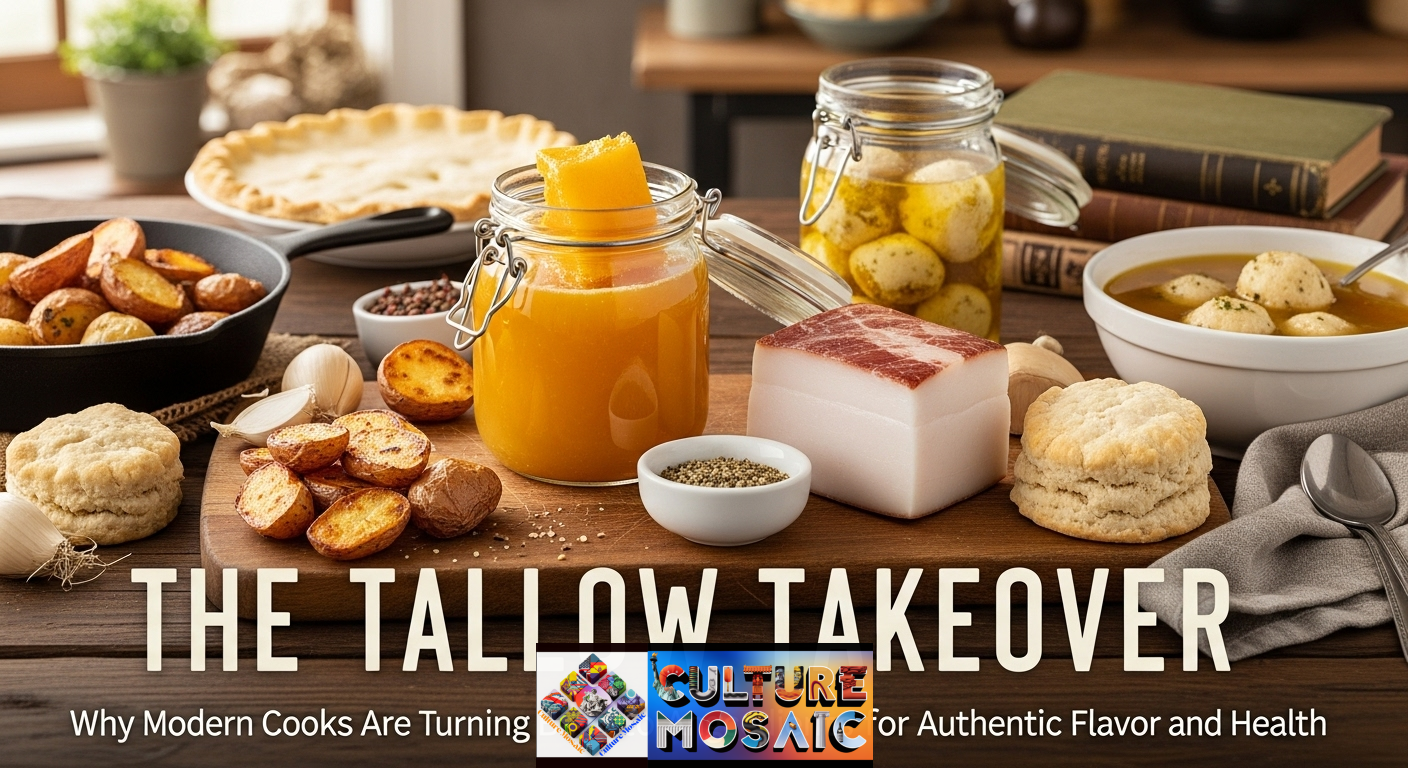In kitchens across America, a quiet revolution is happening. Home cooks and professional chefs alike are rediscovering ancestral ingredients that their grandparents used daily—beef tallow, pork lard, and chicken schmaltz. These traditional cooking fats, once dismissed as unhealthy relics, are experiencing a remarkable comeback as people seek authenticity, superior flavor, and genuine nutrition in their food.
This isn’t just nostalgia. It’s a thoughtful return to ancestral ingredients that supported human health for millennia, coupled with modern understanding of why they work so well. Whether you’re following a keto or paleo lifestyle, looking to reduce processed foods, or simply want your roasted potatoes to taste like your grandmother’s, ancestral ingredients offer a path back to real food and real flavor.
The Great Fat Debate: How We Lost Our Culinary Heritage
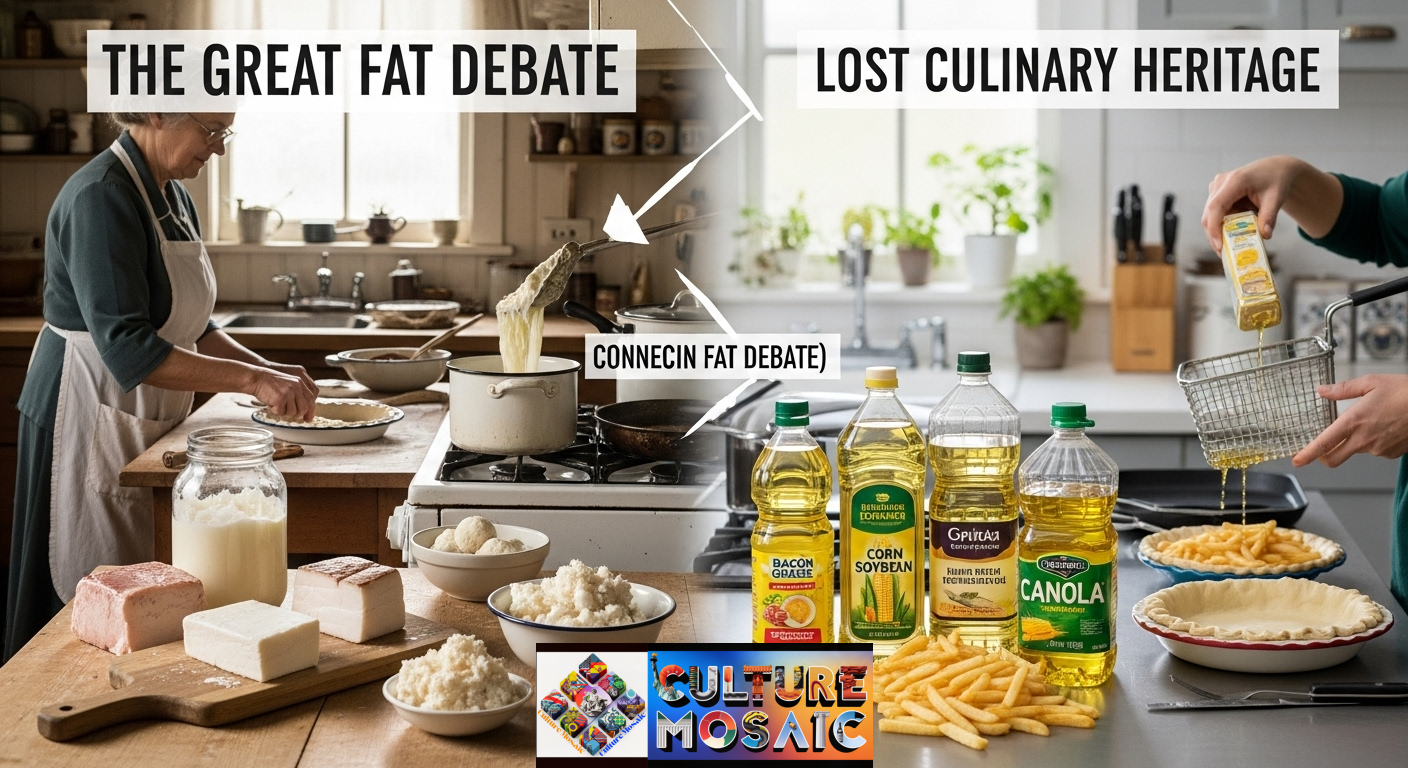
For most of human history, ancestral ingredients like animal fats were kitchen staples. Your great-grandmother likely kept a jar of bacon grease by the stove, rendered her own lard for pie crusts, and saved chicken fat for matzo balls. These weren’t just economical choices—they were culinary wisdom passed down through generations.
The shift away from ancestral ingredients began in the mid-20th century when processed vegetable oils were marketed as healthier alternatives. Companies promoted seed oils like corn, soybean, and canola oil as “heart-healthy,” while traditional fats were vilified. This messaging was so effective that within a generation, knowledge of rendering and cooking with ancestral ingredients nearly disappeared from American kitchens.
But here’s what happened: as we replaced ancestral ingredients with highly processed alternatives, our food changed. French fries didn’t taste the same. Pie crusts lost their flakiness. Traditional recipes passed down for centuries suddenly fell flat because they were designed around the properties of specific ancestral ingredients.
Today, we’re experiencing what food historians call “newstalgia”—a return to traditional methods with modern consciousness. People are questioning the processed food narrative and rediscovering that ancestral ingredients aren’t the villains they were made out to be. In fact, these traditional fats offer unique nutritional benefits and cooking properties that vegetable oils simply can’t match.
Understanding Ancestral Ingredients: Tallow, Lard, and Schmaltz
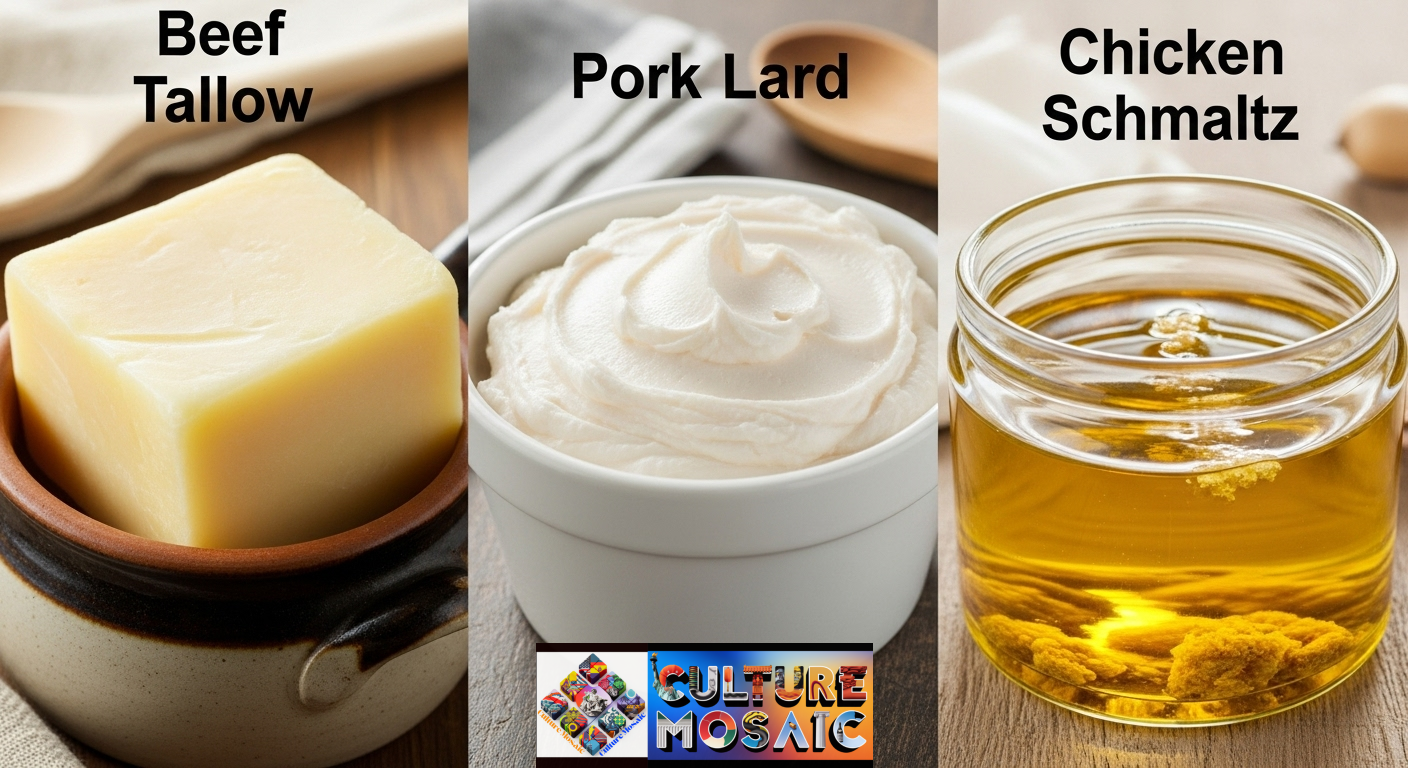
Not all ancestral ingredients are created equal. Each traditional fat has distinct properties, flavors, and ideal uses. Understanding these differences helps you choose the right ancestral cooking for each dish.
Beef Tallow: The High-Heat Champion
Beef tallow is rendered fat from cattle, primarily from the area around the kidneys (suet). This ancestral ingredient has an incredibly high smoke point—around 400°F—making it perfect for high-heat cooking. Tallow creates the crispiest roasted vegetables and produces French fries with that distinctive flavor fast-food chains used to have before switching to vegetable oils.
Beyond its cooking properties, beef tallow contains conjugated linoleic acid (CLA) and fat-soluble vitamins A, D, E, and K. When sourced from grass-fed cattle, this ancestral ingredient provides an even richer nutrient profile. The neutral, slightly savory flavor of tallow complements rather than overwhelms dishes, making it versatile for both savory and some sweet applications.
Pork Lard: The Baker’s Secret Weapon
Lard is rendered pork fat, and it’s the ancestral ingredient that professional bakers swear by for the flakiest pie crusts and biscuits. With a smoke point around 370°F, lard works beautifully for frying, sautéing, and especially baking. The fat molecules in lard create layers in pastry that butter alone can’t achieve.
There are two types of lard to know: leaf lard (from around the kidneys) has a mild, almost neutral flavor ideal for baking, while back fat lard has a more pronounced pork flavor better suited for savory dishes. This ancestral ingredient is rich in monounsaturated fats—the same type found in olive oil—and contains vitamin D, a nutrient many Americans lack.
Schmaltz: Liquid Gold of Jewish Cuisine
Schmaltz is rendered chicken or goose fat, and it’s the ancestral ingredient that gives Jewish deli food its distinctive, irreplaceable flavor. With a lower smoke point around 375°F, schmaltz is perfect for sautéing vegetables, crisping potatoes, and adding depth to soups and stews.
This ancestral ingredient brings an almost buttery richness to dishes while being dairy-free, making it essential for kosher cooking. Schmaltz contains oleic acid (also found in olive oil) and provides that soul-satisfying quality that makes matzo ball soup truly comforting. The gribenes (crispy chicken skin bits) left after rendering are a delicious bonus that represents zero-waste cooking at its finest.
Health Benefits: Why Ancestral Ingredients Deserve a Second Look
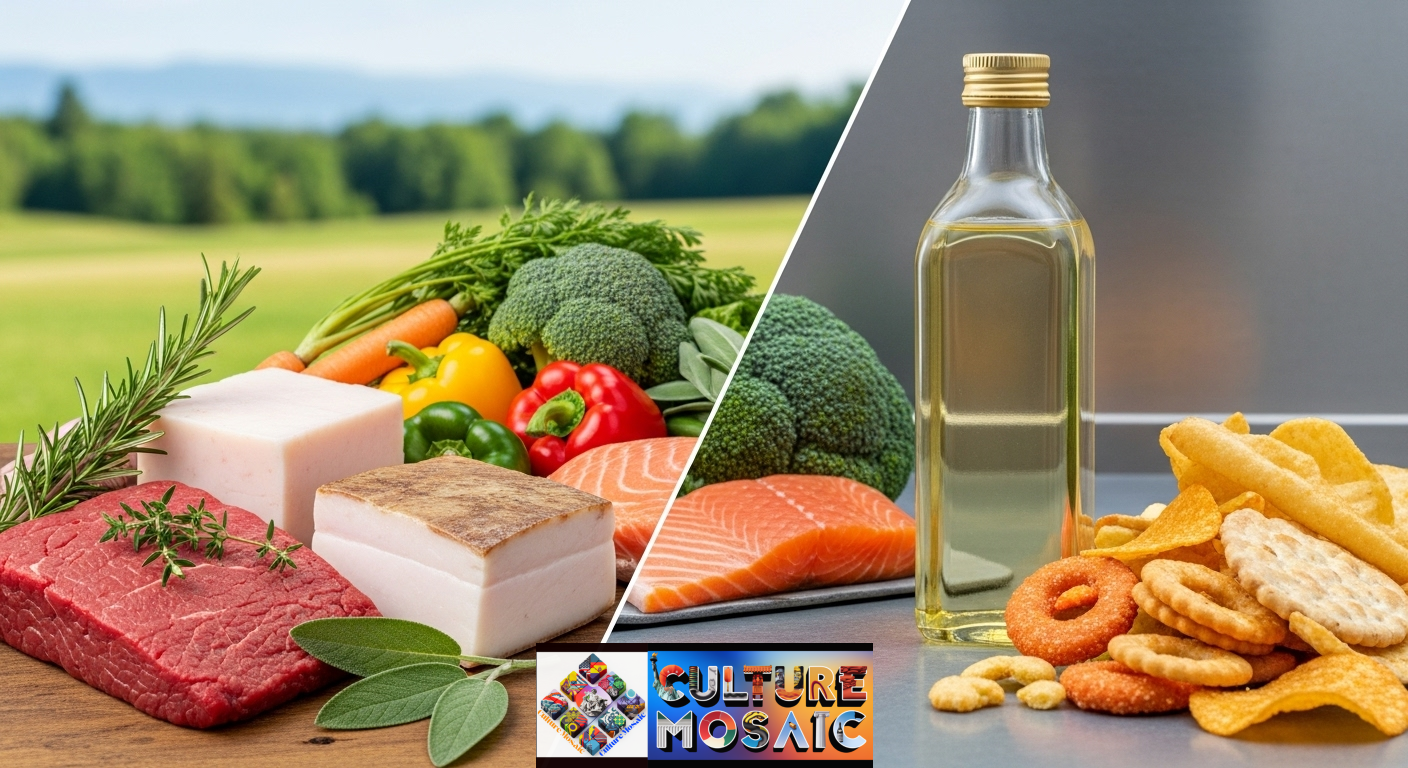
The rehabilitation of ancestral ingredients isn’t just about flavor—it’s backed by evolving nutritional science. While we’re not claiming these fats are miracle foods, the evidence suggests they’re far healthier than the processed alternatives that replaced them.
Nutrient Density That Seed Oils Can’t Match
Unlike refined vegetable oils, ancestral ingredients are minimally processed and contain fat-soluble vitamins that your body needs. Grass-fed beef tallow provides vitamins A, D, E, and K2, which support everything from immune function to bone health. Lard contains vitamin D, particularly important given that much of the US population is deficient. These nutrients occur naturally in ancestral ingredients and are easily absorbed by your body because they’re in fat, which is exactly how your body prefers to process them.
Stable Fats for High-Heat Cooking
One of the strongest arguments for ancestral ingredients is their stability at high temperatures. Seed oils high in polyunsaturated fats oxidize when heated, creating compounds that may contribute to inflammation. Ancestral ingredients like tallow and lard are predominantly saturated and monounsaturated fats, which remain stable at cooking temperatures, making them safer choices for frying and roasting.
Supporting Metabolic Health
Ancestral ingredients align with ketogenic and paleo dietary approaches, which have shown benefits for weight management, blood sugar control, and metabolic health. These fats provide sustained energy without spiking blood sugar and help you feel satisfied after meals. While individual results vary, many people report better energy levels and reduced cravings when they replace seed oils with traditional ancestral ingredients.
The Omega Balance
Wild-caught and grass-fed animals produce ancestral ingredients with a better ratio of omega-3 to omega-6 fatty acids compared to their grain-fed counterparts. The modern American diet is heavily skewed toward omega-6 fats (predominantly from seed oils), which may contribute to inflammation. Using ancestral ingredients from quality sources helps restore a more balanced fat intake.
From Rendering to Cooking: Practical Ways to Use Ancestral Ingredients
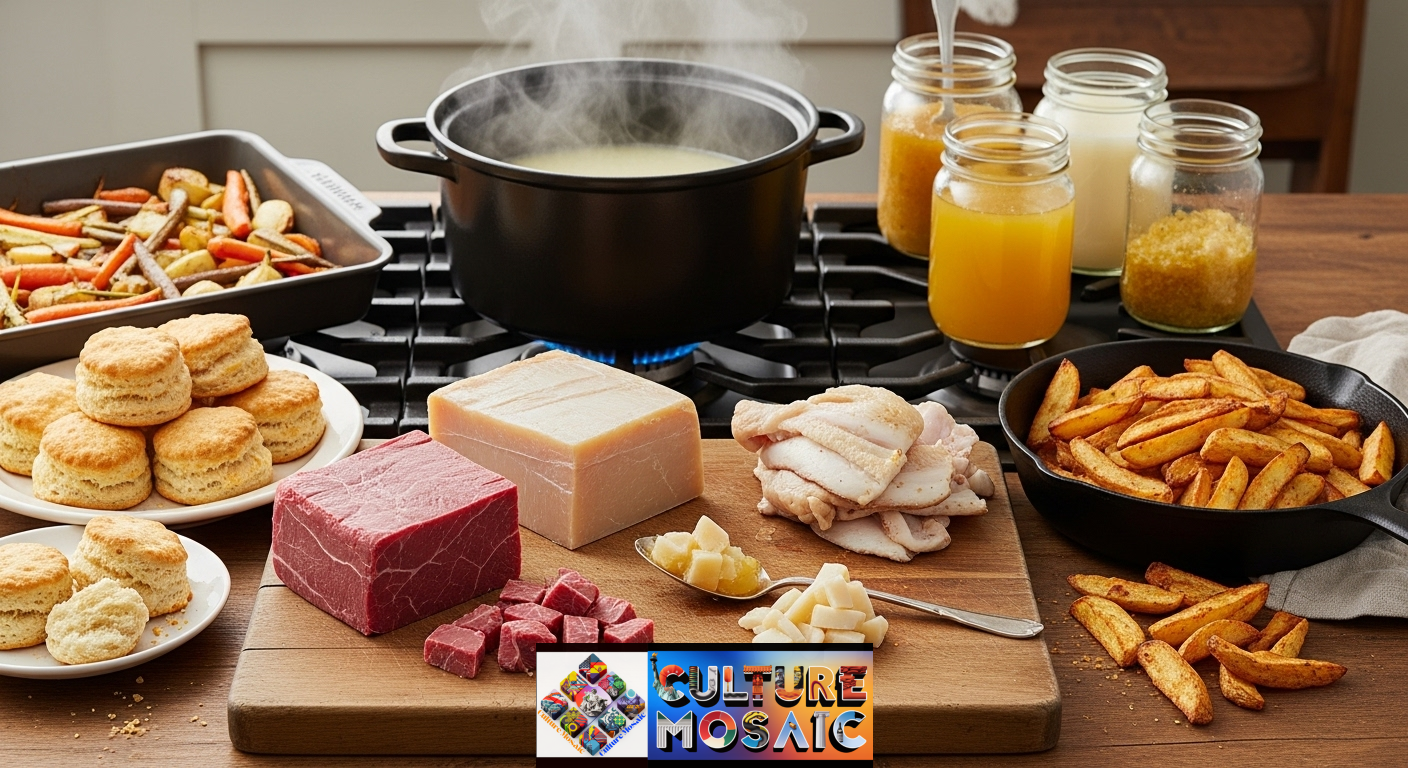
Ready to bring ancestral ingredients into your kitchen? Here’s how to source, prepare, and cook with these traditional fats.
Sourcing Quality Ancestral Ingredients
You can buy pre-rendered ancestral ingredients or render your own. For purchased options, look for grass-fed beef tallow, pasture-raised pork lard, and organic chicken schmaltz at natural food stores or online. Many butcher shops sell raw fat (suet, leaf lard, chicken skins) inexpensively if you want to render your own.
Rendering is surprisingly simple: cut the fat into small pieces, heat slowly in a heavy pot or slow cooker, strain out the solids, and store the liquid gold in jars. Home-rendered ancestral ingredients cost a fraction of store-bought versions and give you complete control over quality.
Crispy Tallow-Fried Potatoes
This recipe showcases why beef tallow is the ultimate ancestral ingredient for crispy potatoes. Cut russet potatoes into wedges, parboil for 5 minutes, drain, and dry thoroughly. Heat beef tallow in a cast-iron skillet or Dutch oven to 350°F. Fry potatoes in batches until deeply golden, about 6-8 minutes. The result? Potatoes with a crispy exterior and fluffy interior that taste like they came from a 1950s diner—because that’s exactly what diners used before switching to cheaper oils.
Flaky Biscuits with Lard
Discover why lard is the ancestral ingredient bakers treasure. Mix 2 cups of flour, 1 tablespoon of baking powder, and 1 teaspoon of salt. Cut in ½ cup cold lard until the mixture resembles coarse crumbs. Add ¾ cup cold milk and stir just until combined. Pat dough to ¾-inch thickness, cut with a biscuit cutter, and bake at 450°F for 12-15 minutes. These biscuits rise higher and flake apart more beautifully than any made with butter or shortening—a perfect example of ancestral ingredients producing superior results.
Schmaltz-Roasted Root Vegetables
Let schmaltz, that treasured ancestral ingredient, transform humble vegetables into something extraordinary. Toss carrots, parsnips, and turnips with melted schmaltz, salt, and pepper. Roast at 425°F until caramelized, about 35-40 minutes. The savory depth that schmaltz provides elevates these vegetables far beyond what olive oil can achieve, connecting you directly to generations of home cooks who knew this ancestral ingredient’s magic.
The Zero-Waste Tradition: Ancestral Ingredients and Sustainable Cooking
Perhaps the most compelling aspect of ancestral ingredients is how they embody nose-to-tail, zero-waste cooking—a value increasingly important to conscious consumers.
Honoring the Whole Animal
Using ancestral ingredients means nothing goes to waste. When you buy a chicken and render the fat for schmaltz, use the bones for stock, and cook every part, you’re practicing the resourcefulness that defined cooking for millennia. This ancestral ingredient approach honors the animal by using everything it provides.
In contrast, the industrial food system often wastes these valuable fats or processes them into products far removed from food. When you choose ancestral ingredients, you’re participating in a more respectful, sustainable food system.
Reducing Processed Food Dependence
Ancestral ingredients help you move away from ultra-processed foods. When you’re cooking with tallow, lard, or schmaltz, you’re using ingredients your great-grandparents would recognize—real food, not industrial products created in the last few decades. This shift toward ancestral ingredients naturally reduces your consumption of packaged foods, industrial seed oils, and artificial additives.
Supporting Regenerative Agriculture
Sourcing ancestral ingredients from farms practicing regenerative agriculture—where cattle graze on pasture and chickens forage naturally—supports farming methods that build soil health and sequester carbon. These ancestral ingredients connect you to an agricultural system that’s better for animals, land, and climate.
Modern Kitchens, Traditional Wisdom: Making Ancestral Ingredients Work for You
Integrating ancestral ingredients into modern cooking doesn’t mean abandoning contemporary nutrition knowledge or giving up plant-based oils entirely. It means expanding your options and using each fat where it performs best.
When to Choose Ancestral Ingredients
Use beef tallow for high-heat roasting and frying when you want maximum crispiness. Reach for lard when making pastry or baking where flakiness matters. Use schmaltz when sautéing vegetables or cooking traditional dishes where its distinctive flavor is essential. These ancestral ingredients aren’t meant to replace every fat in your kitchen—they’re meant to reclaim their rightful place alongside modern options.
Storage and Shelf Life
Properly stored ancestral ingredients last surprisingly long. Keep rendered fats in sealed jars in the refrigerator for up to a year, or freeze for even longer storage. Unlike some oils that go rancid quickly, these ancestral ingredients remain stable thanks to their saturated fat content. This stability is one reason our ancestors relied on them—they didn’t need refrigeration and could be stored through winter.
Starting Your Journey with Ancestral Ingredients
If you’re new to ancestral ingredients, start simple. Replace the oil in your next batch of roasted potatoes with beef tallow. Make one pie crust with lard and compare it to your butter version. Sauté onions in schmaltz and notice the depth of flavor it brings to the soup. These small experiments will quickly show you why generations of cooks considered these ancestral ingredients irreplaceable.
The Social Media Moment: Why Ancestral Ingredients Are Going Viral
The resurgence of ancestral ingredients isn’t just happening in restaurants and home kitchens—it’s exploding across social media. On TikTok, Instagram, and YouTube, food creators are sharing the “tallow takeover,” demonstrating how these ancestral ingredients produce dramatically better results than modern alternatives.
Videos of golden-brown potatoes crisped in beef tallow rack up millions of views. Home cooks share side-by-side comparisons of pie crusts made with lard versus shortening, and the difference is visible and compelling. This viral momentum reflects genuine curiosity about ancestral ingredients and traditional cooking methods.
What makes this trend particularly powerful is its authenticity. Unlike many food fads, ancestral ingredients have centuries of proven use. When a grandmother comments on a TikTok video, “This is how we always made it,” confirming the ancestral ingredient technique, it validates both the traditional method and the modern rediscovery.
Cultural Heritage on a Plate: Ancestral Ingredients and Identity
Beyond nutrition and flavor, ancestral ingredients carry cultural significance. They connect us to our heritage and preserve culinary traditions that define communities.
For Jewish families, schmaltz isn’t just an ancestral ingredient—it’s a link to Eastern European roots and the ingenuity of making the most of every ingredient in times of scarcity. For Southern cooks, lard represents generations of bakers perfecting biscuits and pie crusts. For those with ranching heritage, beef tallow connects to a time when every part of the cattle was valued.
When you cook with ancestral ingredients, you’re not just making food—you’re participating in living history. You’re keeping techniques alive that might otherwise disappear. In our globalized food system, where meals often have no clear origin, ancestral ingredients provide cultural anchor points, reminding us where food comes from and who we come from.
The Future of Ancestral Ingredients in American Cooking
As more Americans discover the benefits of ancestral ingredients, we’re witnessing a permanent shift in how people think about cooking fats. This isn’t a temporary trend—it’s a correction to decades of misguided nutrition advice and a return to what works.
Farmers’ markets now feature grass-fed tallow and pasture-raised lard alongside vegetables and meat. Restaurants highlight ancestral ingredients on menus, proudly noting their tallow-fried potatoes or lard-crust tarts. Cookbooks dedicated to traditional fats are bestsellers. Even mainstream grocery stores are expanding their selection of ancestral ingredients.
This renaissance benefits everyone. Farmers gain additional income from parts of animals previously discarded. Consumers access genuinely nutritious, flavorful ingredients. Home cooks discover that better food doesn’t require fancy techniques—sometimes it just requires returning to the ancestral ingredients that worked all along.
The lesson of ancestral ingredients extends beyond cooking fats. It reminds us to question food industry narratives, to look to traditional wisdom, and to trust our taste buds. When food tastes better—when potatoes achieve that perfect crispiness, when pie crust shatters into flaky layers, when soup has that ineffable richness—it’s often because we’re using the ancestral ingredients the recipe was designed around.
Getting Started: Your Ancestral Ingredients Action Plan
Ready to experience the difference ancestral ingredients make? Here’s your practical starting point:
This Week: Purchase a jar of grass-fed beef tallow or pasture-raised lard from a natural foods store or online retailer. Read reviews to find quality sources—other consumers are excellent guides to good ancestral ingredient.
This Weekend: Try one simple recipe that showcases your chosen ancestral ingredient. Roast vegetables in tallow or make biscuits with lard. Pay attention to the flavor, texture, and how differently these ancestral ingredient perform compared to what you usually use.
This Month: If you’re feeling adventurous, try rendering your own fat from raw suet, leaf lard, or chicken skins. The process is meditative and economical, and produces ancestral ingredients at a fraction of retail cost.
This Year: Gradually incorporate ancestral ingredients into your regular cooking rotation. Note which dishes benefit most and adjust accordingly. Share your discoveries with friends and family—these ancestral ingredients work best when the knowledge spreads.
As you explore ancestral ingredient, remember that you’re part of a larger movement reclaiming real food and real flavor. You’re connecting with generations of cooks who knew these ingredients’ value. And you’re discovering that sometimes, the most innovative thing we can do in the kitchen is remember what we’ve forgotten.
Frequently Asked Questions About Ancestral Ingredients
Q: Are ancestral ingredients like tallow and lard actually healthier than vegetable oils?
A: Ancestral ingredients offer several advantages over refined seed oils. They contain fat-soluble vitamins (A, D, E, K), remain stable at high cooking temperatures without oxidizing, and provide a better balance of fatty acids when sourced from grass-fed or pasture-raised animals. While no single fat is perfect for all uses, ancestral ingredient are minimally processed, nutrient-dense options that have supported human health for thousands of years. They’re particularly beneficial for high-heat cooking, where seed oils may break down and form harmful compounds.
Q: Where can I buy quality ancestral ingredients like beef tallow and lard?
A: Quality ancestral ingredients are increasingly available at natural food stores, farmers’ markets, and online retailers like Fatworks, Epic, or US Wellness Meats. Look for grass-fed beef tallow, pasture-raised pork lard, and organic chicken schmaltz. Local butcher shops often sell raw fat (suet, leaf lard) inexpensively if you want to render your own ancestral ingredient. When purchasing, choose products from animals raised without antibiotics or hormones for the highest quality and best nutritional profile.
Q: Can I render my own ancestral ingredients at home, and is it difficult?
A: Rendering your own ancestral ingredients is surprisingly simple and economical. For beef tallow or pork lard, cut raw fat into small pieces, place it in a heavy pot or slow cooker on low heat, and let it melt slowly for several hours. Strain out the solid bits (save them—they’re delicious!), and store the liquid fat in jars. For schmaltz, save chicken skins and fat, cook them slowly until the fat renders and skins turn golden, then strain. Home-rendered ancestral ingredient cost significantly less than store-bought and give you complete control over quality.
Q: What’s the best ancestral ingredient for frying crispy potatoes?
A: Beef tallow is the ultimate ancestral ingredient for crispy potatoes and French fries. With a smoke point around 400°F, tallow can handle high frying temperatures while creating an incredibly crispy exterior and that nostalgic flavor fast-food fries had before chains switched to vegetable oils. The saturated fat structure of this ancestral ingredient produces superior browning and texture that seed oils simply cannot match. For the best results, cut potatoes uniformly, dry them thoroughly, and fry in tallow heated to 350-375°F.
Q: How long do ancestral ingredients last, and how should I store them?
A: Properly stored ancestral ingredients have an impressive shelf life due to their saturated fat content, which resists rancidity. Keep rendered tallow, lard, or schmaltz in sealed glass jars or containers in the refrigerator for up to a year, or freeze for even longer storage. These ancestral ingredient remain solid or semi-solid when refrigerated, making them easy to scoop out as needed. Unlike many seed oils that go rancid relatively quickly, especially after opening, ancestral ingredient maintain quality and flavor for extended periods, which is one reason they were kitchen staples before refrigeration was common.

